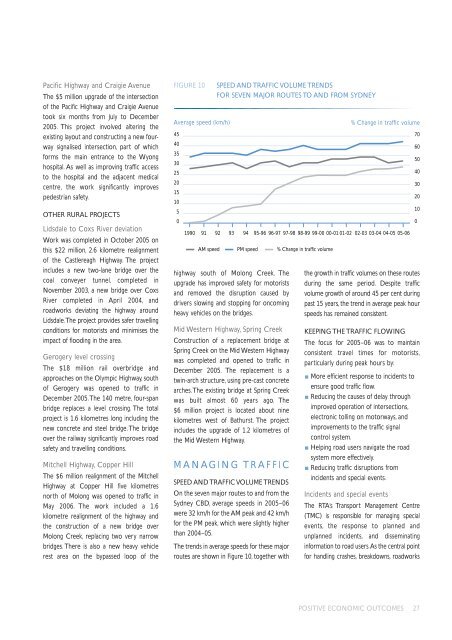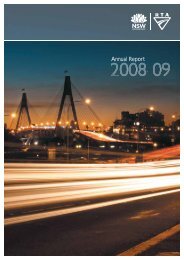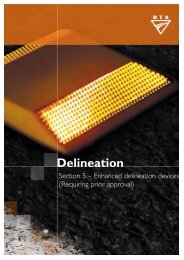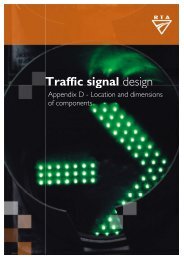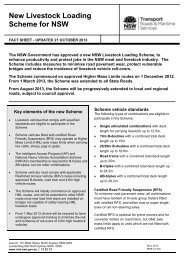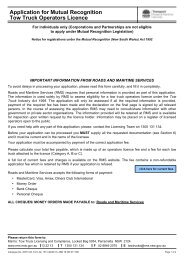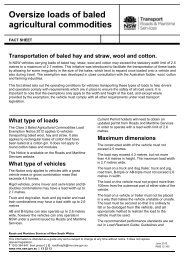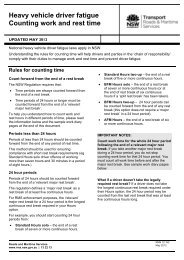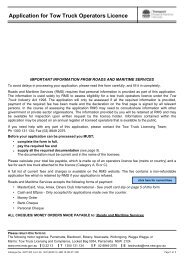Annual Report 2006 (main body) - RTA - NSW Government
Annual Report 2006 (main body) - RTA - NSW Government
Annual Report 2006 (main body) - RTA - NSW Government
You also want an ePaper? Increase the reach of your titles
YUMPU automatically turns print PDFs into web optimized ePapers that Google loves.
Pacific Highway and Craigie Avenue<br />
The $5 million upgrade of the intersection<br />
of the Pacific Highway and Craigie Avenue<br />
took six months from July to December<br />
2005. This project involved altering the<br />
existing layout and constructing a new fourway<br />
signalised intersection, part of which<br />
forms the <strong>main</strong> entrance to the Wyong<br />
hospital. As well as improving traffic access<br />
to the hospital and the adjacent medical<br />
centre, the work significantly improves<br />
pedestrian safety.<br />
OTHER RURAL PROJECTS<br />
Lidsdale to Coxs River deviation<br />
Work was completed in October 2005 on<br />
this $22 million, 2.6 kilometre realignment<br />
of the Castlereagh Highway. The project<br />
includes a new two-lane bridge over the<br />
coal conveyer tunnel, completed in<br />
November 2003, a new bridge over Coxs<br />
River completed in April 2004, and<br />
roadworks deviating the highway around<br />
Lidsdale.The project provides safer travelling<br />
conditions for motorists and minimises the<br />
impact of flooding in the area.<br />
Gerogery level crossing<br />
The $18 million rail overbridge and<br />
approaches on the Olympic Highway, south<br />
of Gerogery was opened to traffic in<br />
December 2005.The 140 metre, four-span<br />
bridge replaces a level crossing. The total<br />
project is 1.6 kilometres long including the<br />
new concrete and steel bridge. The bridge<br />
over the railway significantly improves road<br />
safety and travelling conditions.<br />
Mitchell Highway, Copper Hill<br />
The $6 million realignment of the Mitchell<br />
Highway at Copper Hill five kilometres<br />
north of Molong was opened to traffic in<br />
May <strong>2006</strong>. The work included a 1.6<br />
kilometre realignment of the highway and<br />
the construction of a new bridge over<br />
Molong Creek, replacing two very narrow<br />
bridges. There is also a new heavy vehicle<br />
rest area on the bypassed loop of the<br />
FIGURE 10<br />
Average speed (km/h)<br />
45<br />
40<br />
35<br />
30<br />
25<br />
20<br />
15<br />
10<br />
5<br />
0<br />
SPEED AND TRAFFIC VOLUME TRENDS<br />
FOR SEVEN MAJOR ROUTES TO AND FROM SYDNEY<br />
1990 91 92 93 94 95-96 96-97 97-98 98-99 99-00 00-01 01-02 02-03 03-04 04-05 05-06<br />
AM speed PM speed % Change in traffic volume<br />
highway south of Molong Creek. The<br />
upgrade has improved safety for motorists<br />
and removed the disruption caused by<br />
drivers slowing and stopping for oncoming<br />
heavy vehicles on the bridges.<br />
Mid Western Highway, Spring Creek<br />
Construction of a replacement bridge at<br />
Spring Creek on the Mid Western Highway<br />
was completed and opened to traffic in<br />
December 2005. The replacement is a<br />
twin-arch structure, using pre-cast concrete<br />
arches.The existing bridge at Spring Creek<br />
was built almost 60 years ago. The<br />
$6 million project is located about nine<br />
kilometres west of Bathurst. The project<br />
includes the upgrade of 1.2 kilometres of<br />
the Mid Western Highway.<br />
MANAGING TRAFFIC<br />
SPEED AND TRAFFIC VOLUME TRENDS<br />
On the seven major routes to and from the<br />
Sydney CBD, average speeds in 2005–06<br />
were 32 km/h for the AM peak and 42 km/h<br />
for the PM peak, which were slightly higher<br />
than 2004–05.<br />
The trends in average speeds for these major<br />
routes are shown in Figure 10, together with<br />
% Change in traffic volume<br />
the growth in traffic volumes on these routes<br />
during the same period. Despite traffic<br />
volume growth of around 45 per cent during<br />
past 15 years, the trend in average peak hour<br />
speeds has re<strong>main</strong>ed consistent.<br />
KEEPING THE TRAFFIC FLOWING<br />
The focus for 2005–06 was to <strong>main</strong>tain<br />
consistent travel times for motorists,<br />
particularly during peak hours by:<br />
More efficient response to incidents to<br />
ensure good traffic flow.<br />
Reducing the causes of delay through<br />
improved operation of intersections,<br />
electronic tolling on motorways, and<br />
improvements to the traffic signal<br />
control system.<br />
Helping road users navigate the road<br />
system more effectively.<br />
Reducing traffic disruptions from<br />
incidents and special events.<br />
Incidents and special events<br />
The <strong>RTA</strong>’s Transport Management Centre<br />
(TMC) is responsible for managing special<br />
events, the response to planned and<br />
unplanned incidents, and disseminating<br />
information to road users.As the central point<br />
for handling crashes, breakdowns, roadworks<br />
70<br />
60<br />
50<br />
40<br />
30<br />
20<br />
10<br />
0<br />
POSITIVE ECONOMIC OUTCOMES 27


